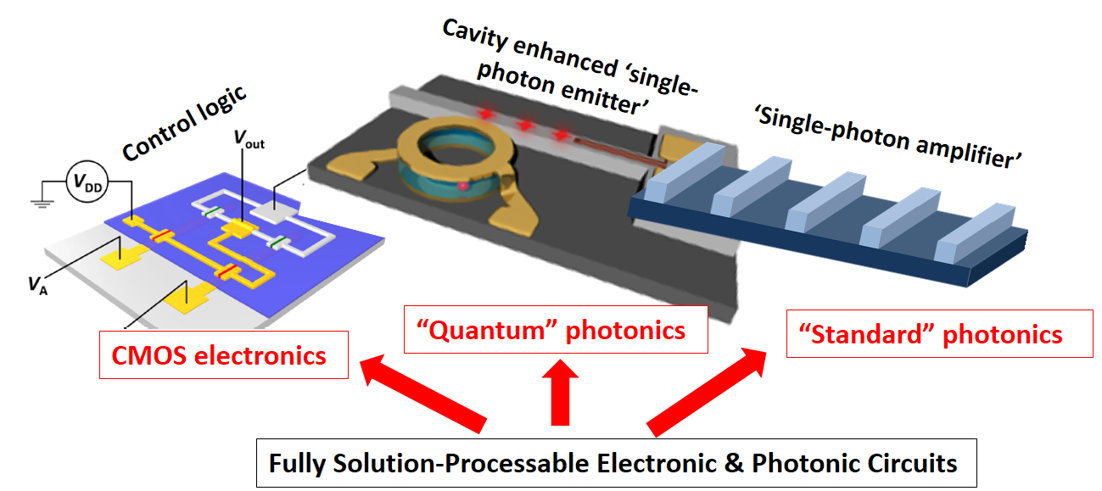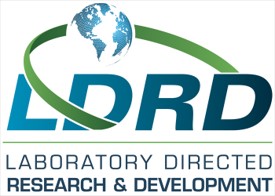
Project Overview
The Overarching Objective of this project is to demonstrate the utility of quantum-confined colloidal nanocrystals as highly-versatile, solution-processible materials for implementing wavelength-selectable single-photon emitters (SPEs) complemented by spectrally matched on-chip light-amplification circuits, laser sources, and logic-gate devices.

Background
Quantum photonics explores and exploits quantum states of light in the context of quantum computing, communication, imaging, and metrology, the sub-fields of quantum information science (QIS). A key element of any quantum photonic circuit is a ‘single-photon emitter’ (SPE). An ideal SPE delivers exactly one photon at a designated time – no more, no less – and, importantly, all emitted photons are ‘indistinguishable’, that is, quantum-mechanically identical in wavelength, phase, polarization, and direction. Zero-dimensional (0D) Semiconductor 'quantum dots' (QDs) fabricated via epitaxial approaches have emerged as a highly promising SPE platform. While demonstrating the tremendous potential of 0D-structures in QIS, epitaxial QDs have several shortcomings including a fairly narrow operational spectral range (~800−1100 nm), dot-to-dot variations in the emission energy due to size polydispersity, difficulty for on-chip integration, and the need for cryogenic liquid-helium (He) cooling.
Goals
Here we propose that by using a colloidal form of QDs − chemically synthesized nanocrystals (NCs) − we can address the limitations of epitaxial-QD SPEs while retaining the advantages of 0D-systems. In particular, strongly confined NCs can easily access the small-size regime where the spacing between their discrete atomic-like electronic states greatly exceeds typical thermal energies, which mitigates the effects of thermal noise. In addition, they feature ‘quantized’ vibrational modes characterized by large energies, which simplifies isolation of optically coherent exciton emission. Further, by manipulating confined electronic and phonon states, it is possible to extend exciton coherence.
The goal of this project is to exploit the unmatched flexibility of colloidal NCs for demonstrating atomic-like emitters with long-lived optical coherence that is preserved at elevated temperatures. In addition, we aim to exploit a size-controlled NC band gap for realizing high-fidelity sources of quantum light with an arbitrary wavelength tunable across both visible and near-infrared (NIR) ranges. A further objective is to implement integrated NC-photonic circuits, through which we will be able to excite a selected NC (or an NC group) and then read out desired information on demand. This will demonstrate the ‘integrability’ and scalability of the NC-SPE approach and, in addition, will provide a powerful capability for systematic studies of the effects of controlled photonic environment on SPE-related NC properties.

Thrust 1 (PHYS): Fundamental photophysics of NC emitters. Attain in-depth understanding of light-emitting properties of quantum-confined NCs in single- and multi-exciton regimes.
- Elucidate factors controlling single-photon purity and excitonic coherence with focus on single-NC emitters
- Investigate interplay between radiative and nonradiative processes (in particular, Auger recombination) in the regimes of spontaneous and stimulated emission in the context of ‘single-photon’ amplification
Thrust 2 (CHEM): Chemical manipulation of NC light-emitting properties. Develop high-performance NCs for applications as color-selectable SPEs and high-efficiency multiexciton emitters/amplifiers with focus on materials for Vis and near-IR spectral ranges.
- Chemical controls of excitonic spectra and decoherence
- Engineered multiexciton interactions (giant X-X repulsion and suppressed Auger decay)
- Synthetic approaches to ‘identical’ single-NC emitters with indistinguishable characteristics
Thrust 3 (INTEG): NC integration with photonic and electronic structures. Explore effects of NC coupling to on-chip photonic structures (e.g., cavities and waveguides) for implementing cavity-enhanced SPEs and spectrally matched light amplifiers.
- Photonic enhancement of emission rates and excitonic coherence
- Engineered multiexciton interactions (giant X-X repulsion and suppressed Auger decay)
- On-chip logic gates for real-time control of NC emitters & light amplifiers
Principal Investigator


December 2020
